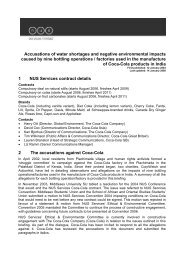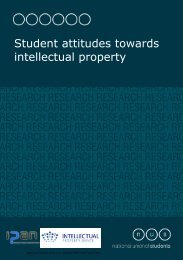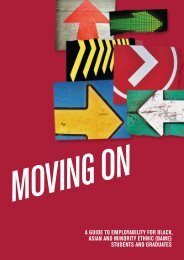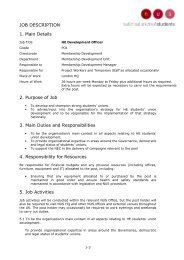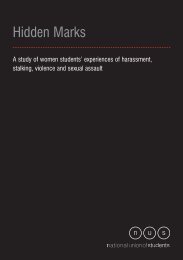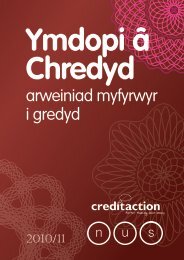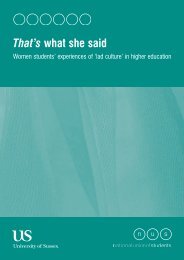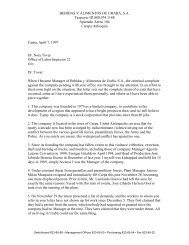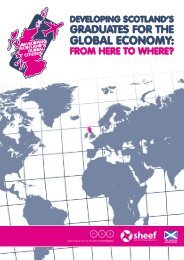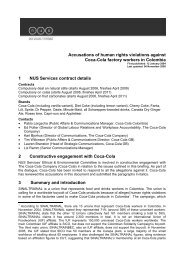Review of Institutional Complaints and Appeals Procedures in ...
Review of Institutional Complaints and Appeals Procedures in ...
Review of Institutional Complaints and Appeals Procedures in ...
Create successful ePaper yourself
Turn your PDF publications into a flip-book with our unique Google optimized e-Paper software.
circumstances before the exam or assessment, however they make students aware <strong>of</strong> this,<br />
<strong>and</strong> what they mean by extenuat<strong>in</strong>g circumstances, on their student portal dur<strong>in</strong>g exam time.<br />
At another <strong>in</strong>stitution they are expected to <strong>in</strong>form the <strong>in</strong>stitution <strong>of</strong> extenuat<strong>in</strong>g circumstances<br />
before the exam board – i.e. about ten days after the exam has taken place. Some other<br />
<strong>in</strong>stitutions allow students to submit extenuat<strong>in</strong>g circumstances after the assessment but the<br />
student will need substantial evidence.<br />
One <strong>in</strong>stitution <strong>in</strong>cluded the procedure for appeal on the bottom <strong>of</strong> the results letter <strong>and</strong> this<br />
resulted <strong>in</strong> a significant <strong>in</strong>creased <strong>in</strong> the number <strong>of</strong> compla<strong>in</strong>ts but without actually <strong>in</strong>creas<strong>in</strong>g<br />
the number <strong>of</strong> valid cases. Institutions <strong>in</strong>creas<strong>in</strong>gly operate a filter<strong>in</strong>g process to identify<br />
vexatious cases but this should be monitored to ensure student confidence <strong>in</strong> the procedure<br />
<strong>and</strong> it would be worth consider<strong>in</strong>g <strong>in</strong>clud<strong>in</strong>g a representative from the students’ union <strong>in</strong> the<br />
process.<br />
The QAA Precept refers to “easily comprehensible” <strong>in</strong>formation <strong>and</strong> we should therefore<br />
consider the language that the procedures are written <strong>in</strong>. <strong>Procedures</strong> should be written <strong>in</strong> pla<strong>in</strong><br />
English <strong>and</strong> it is important to consider phrases such as “extenuat<strong>in</strong>g circumstances” <strong>and</strong> how<br />
these are expla<strong>in</strong>ed to students, especially <strong>in</strong>ternational students.<br />
More worry<strong>in</strong>g a third <strong>of</strong> <strong>in</strong>stitutions do not provide additional relevant <strong>in</strong>formation at the time<br />
a compla<strong>in</strong>t or appeal is made. One respondent replied that this happens <strong>in</strong>formally, if a<br />
student approached the compla<strong>in</strong>ts <strong>of</strong>ficer or Head <strong>of</strong> Academic <strong>Appeals</strong> they would expla<strong>in</strong><br />
the process to them. NUS believes that this should happen as a matter <strong>of</strong> course.<br />
The OIA currently holds regular workshops on specific areas such as academic judgement <strong>and</strong><br />
<strong>in</strong>formal procedures but it could further develop this role <strong>of</strong> shar<strong>in</strong>g <strong>of</strong> practice across the<br />
sector. There is so much experience with<strong>in</strong> the OIA, <strong>and</strong> also with<strong>in</strong> the Academic Registrars<br />
Council, <strong>and</strong> this could be used to improve <strong>in</strong>stitutional procedures.<br />
The NUS believes that the best way to ensure <strong>in</strong>stitutions have appropriate <strong>in</strong>stitutional<br />
compla<strong>in</strong>ts <strong>and</strong> appeals procedures is by establish<strong>in</strong>g a model procedure which <strong>in</strong>stitutions<br />
could adopt if they wanted. Institutions could <strong>of</strong> course, as autonomous bodies, chose not to<br />
follow this model procedure but it could then be the basis for discussions with<strong>in</strong> <strong>in</strong>stitutions,<br />
<strong>and</strong> students’ unions could discuss with their <strong>in</strong>stitution why they chose not to follow the model<br />
procedure.<br />
12




